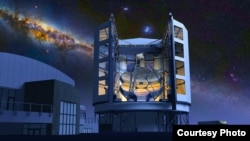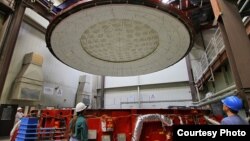Scientists working at the University of Arizona’s Seward Observatory Mirror Lab have begun casting the third of seven mirrors for the Giant Magellan Telescope (GMT) now under construction in Chile.
The GMT, when complete, will be one of the next class of super-giant earth-based telescopes that scientists say promise to revolutionize our view and understanding of the universe.
According to those associated with the project, the GMT will have a resolution 10 times greater than the Hubble Space Telescope.
Like the first two mirrors that have already been made for the giant telescope, the third mirror it is being cast inside a special rotating furnace located in a lab beneath the University of Arizona football field. The Seward Observatory Mirror Lab is said to be the only facility in the world where mirrors of the size to be used in the GMT can be made.
To prepare the mirror for casting, twenty tons of E6 borosilicate glass chunks were carefully placed into a special mold set inside of the furnace. The Lab’s furnace was started up on August 19, at 1400 UTC, with a rotating speed of 4.9 revolutions per minute. It reached a high temperature of 1,165 C at 1649 UTC on Saturday.
The cooling and hardening process on the latest mirror will begin on Thursday – August 29 – when the furnace’s internal temperature is at 530 C. Officials at the at the University of Arizona say that this cooling-down phase is a very gradual process that should take the mirror down to room temperature by Nov. 19.
The lab team is planning to remove the mirror from its mold around the end of November. After it’s removed from the mold, the mirror will then undergo a thorough inspection. Those involved with this project won’t know if their casting efforts are successful until after the inspection is completed.
Once the mirror is successfully inspected, the next step toward completion will be an extensive and precise polishing process. The first of the seven mirrors was cast in 2005 and the polishing process was completed in 2012. The second mirror was cast in 2012 and is now being polished.
Each of the seven primary mirrors will be 8.4 meters in diameter and weigh about 20 tons, but when polished and finished, the mirror surface will be smooth to within a twentieth of a wavelength of light.
Construction in Chile
When all seven mirrors have been finished, they will be transported to where the Giant Magellan Telescope is being constructed: atop a peak – 2,590.8 meters elevation - of the Andes Mountains near several existing telescope facilities at Las Campanas, Chile.
Six of the GMT’s mirrors will be arranged as segments around the seventh forming a virtual single mirror array that will be 24.5 meters in diameter.
The mirror of the Hubble Telescope, which has imaged some of the most spectacular views of the universe, on the other hand, measures about 2.5 meters from one edge to the other.
The Giant Magellan Telescope is scheduled to begin its science operations in 2020.
Those involved with its construction and operation say that it will give astronomers the opportunity of getting answers some of the most pressing questions about the universe – “including the detection, imaging, and characterization of planets orbiting other stars, the nature of dark matter and dark energy, the physics of black holes, and how stars and galaxies evolved during the earliest phases of the universe.”
“Astronomical discovery has always been paced by the power of available telescopes and imaging technology. The GMT allows another major step forward in both sensitivity and image sharpness” said Peter Strittmatter, director of Steward Observatory. “In fact, the GMT will be able to acquire images 10 times sharper than the Hubble Space Telescope and will provide a powerful complement not only to NASA’s 6.5-meter James Webb Space Telescope (JWST), but also to the Atacama Large Millimeter Array (ALMA) and the Large Synoptic Survey Telescope (LSST), both located in the southern hemisphere.”
Overcoming atmospheric distortion
Space telescopes like the Hubble and forthcoming James Webb Space Telescope normally have an advantage over earth-based telescopes because they are able to make their observations outside of Earth’s atmosphere. That allows the space telescopes to take images that are free of distortion created by our atmosphere.
So how can an earth-based telescope take images of the cosmos with the clarity of or better than space telescopes? An international team of astronomers just may have the answer.
In related news, astronomers have developed a new type of optical system that may allow scientists, using Earth-based telescopes to take sharper images of the night sky than ever before.The developers say their new optical system can counteract the blurring effects of the atmosphere by floating a very thin curved glass mirror that vibrates a thousand times per second on a magnetic field that is set about nine meters above the telescope's primary mirror. The latest version of this new system, called MagAO for "Magellan Adaptive Optics” has been put into place at the Magellan II 6.5 meter telescope in Chile.
"As a result, we can see the visible sky more clearly than ever before," said Laird Close of the University of Arizona. "It's almost like having a telescope with a 21-foot mirror in space."
According to its developers, as it was being tested and received its “first light” – first use – the MagAO has been already making important scientific discoveries.
The GMT, when complete, will be one of the next class of super-giant earth-based telescopes that scientists say promise to revolutionize our view and understanding of the universe.
According to those associated with the project, the GMT will have a resolution 10 times greater than the Hubble Space Telescope.
Like the first two mirrors that have already been made for the giant telescope, the third mirror it is being cast inside a special rotating furnace located in a lab beneath the University of Arizona football field. The Seward Observatory Mirror Lab is said to be the only facility in the world where mirrors of the size to be used in the GMT can be made.
To prepare the mirror for casting, twenty tons of E6 borosilicate glass chunks were carefully placed into a special mold set inside of the furnace. The Lab’s furnace was started up on August 19, at 1400 UTC, with a rotating speed of 4.9 revolutions per minute. It reached a high temperature of 1,165 C at 1649 UTC on Saturday.
The cooling and hardening process on the latest mirror will begin on Thursday – August 29 – when the furnace’s internal temperature is at 530 C. Officials at the at the University of Arizona say that this cooling-down phase is a very gradual process that should take the mirror down to room temperature by Nov. 19.
The lab team is planning to remove the mirror from its mold around the end of November. After it’s removed from the mold, the mirror will then undergo a thorough inspection. Those involved with this project won’t know if their casting efforts are successful until after the inspection is completed.
Once the mirror is successfully inspected, the next step toward completion will be an extensive and precise polishing process. The first of the seven mirrors was cast in 2005 and the polishing process was completed in 2012. The second mirror was cast in 2012 and is now being polished.
Each of the seven primary mirrors will be 8.4 meters in diameter and weigh about 20 tons, but when polished and finished, the mirror surface will be smooth to within a twentieth of a wavelength of light.
Construction in Chile
When all seven mirrors have been finished, they will be transported to where the Giant Magellan Telescope is being constructed: atop a peak – 2,590.8 meters elevation - of the Andes Mountains near several existing telescope facilities at Las Campanas, Chile.
Six of the GMT’s mirrors will be arranged as segments around the seventh forming a virtual single mirror array that will be 24.5 meters in diameter.
The mirror of the Hubble Telescope, which has imaged some of the most spectacular views of the universe, on the other hand, measures about 2.5 meters from one edge to the other.
The Giant Magellan Telescope is scheduled to begin its science operations in 2020.
Those involved with its construction and operation say that it will give astronomers the opportunity of getting answers some of the most pressing questions about the universe – “including the detection, imaging, and characterization of planets orbiting other stars, the nature of dark matter and dark energy, the physics of black holes, and how stars and galaxies evolved during the earliest phases of the universe.”
“Astronomical discovery has always been paced by the power of available telescopes and imaging technology. The GMT allows another major step forward in both sensitivity and image sharpness” said Peter Strittmatter, director of Steward Observatory. “In fact, the GMT will be able to acquire images 10 times sharper than the Hubble Space Telescope and will provide a powerful complement not only to NASA’s 6.5-meter James Webb Space Telescope (JWST), but also to the Atacama Large Millimeter Array (ALMA) and the Large Synoptic Survey Telescope (LSST), both located in the southern hemisphere.”
Overcoming atmospheric distortion
Space telescopes like the Hubble and forthcoming James Webb Space Telescope normally have an advantage over earth-based telescopes because they are able to make their observations outside of Earth’s atmosphere. That allows the space telescopes to take images that are free of distortion created by our atmosphere.
So how can an earth-based telescope take images of the cosmos with the clarity of or better than space telescopes? An international team of astronomers just may have the answer.
In related news, astronomers have developed a new type of optical system that may allow scientists, using Earth-based telescopes to take sharper images of the night sky than ever before.The developers say their new optical system can counteract the blurring effects of the atmosphere by floating a very thin curved glass mirror that vibrates a thousand times per second on a magnetic field that is set about nine meters above the telescope's primary mirror. The latest version of this new system, called MagAO for "Magellan Adaptive Optics” has been put into place at the Magellan II 6.5 meter telescope in Chile.
 |
| The MagAO system should give 17 times the resolution of telescopes without it. |
"As a result, we can see the visible sky more clearly than ever before," said Laird Close of the University of Arizona. "It's almost like having a telescope with a 21-foot mirror in space."
According to its developers, as it was being tested and received its “first light” – first use – the MagAO has been already making important scientific discoveries.






